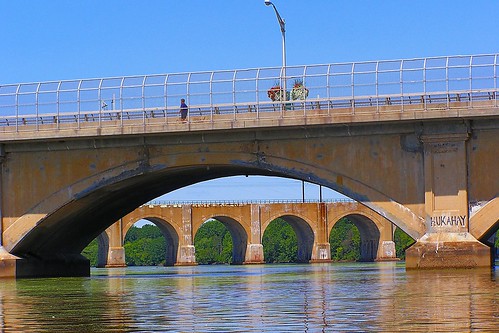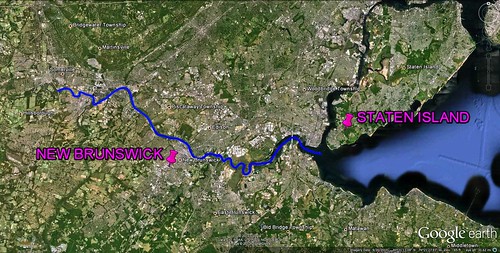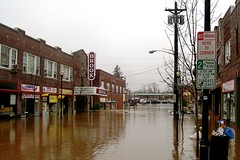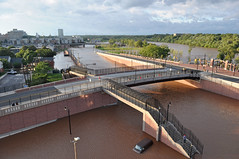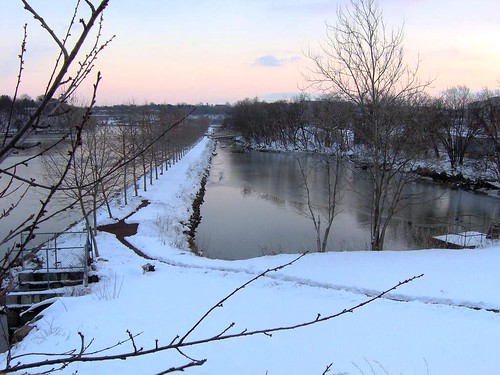Impressive public-private-NGO partnership begins to clean up an urban river

Posted April 8, 2013 at 1:22PM
Because the American legal system provides little in the way of actual authority to solve regional issues, collaboration of one sort or another is often the best available substitute. So, if you want to get something done in a multi-jurisdictional region, assembling over 100 partners comprising the business community (including several major national corporations), municipalities frrom seven counties, 14 state and federal partners, philanthropic and academic institutions, and over 20 conservation organizations is a heck of a start.
New Jersey’s storied Raritan River meanders through a significantly, though not yet fully, urbanized watershed on its way from Somerville (best known in my circles for the annual Tour of Somerville) to Raritan Bay, entering the Bay at Perth Amboy near the southern tip of New York City’s Staten Island. In between, it passes by Piscataway and separates Edison from New Brunswick. It is so associated with New Jersey (within which it is wholly contained) that it is highlighted in the alma mater of Rutgers University, located in New Brunswick.
Over a million people reside in the river’s watershed, where farming, industry and development have delivered an unfortunate soup of contaminants. The website for the Sustainable Raritan River initiative describes them:
“[The Raritan] supports important biological diversity, and has acted as a trade route throughout its history. The impacts of industrial uses and urbanization must be managed while addressing the quantity and quality of water in times of drought and flood.
“Today, the Raritan suffers from pollutants in stormwater runoff from farms and urban development; nitrogen, phosphorus and other discharges from wastewater treatment plants; and contamination from past and presently operating industrial facilities built along its shores. The US Clean Water Act and [New Jersey environmental] regulations have long sought to regulate or control the uses of the River and development along its shores, but their efforts have not been able to remedy the legacy of past transgressions. Developing a shared vision, commitment and agenda for the future is a high priority.”
The mention of flooding is well-placed, in the context of the Raritan’s relatively low-lying watershed. The photos below (showing Bound Brook and New Brunswick, respectively) show the effects.
My friend Judy Shaw, who is also director of the National Center for Neighborhood and Brownfields Redevelopment at Rutgers, directs the Sustainable Raritan initiative. For next week’s annual meeting of the American Planning Association, I agreed to moderate a panel of Judy and her colleagues working on this productive collaborative, which is drawing attention and resources to the river’s challenges in order to improve its water quality. It’s an impressive crew.
To prepare, I look at the partnership’s Action Report, published a couple of years ago, to sense the scope of what it is doing. The report focuses on five priorities:
- Greenways, Recreation and Public Access
- Habitat Preservation and Resource Stewardship
- Remediation and Prevention of Future Pollution
- Water Quality, Stormwater and Infrastructure
- Balancing Redevelopment and Restoration
 (The wording of the priorities has been altered somewhat for the website, but they are substantively the same.)
(The wording of the priorities has been altered somewhat for the website, but they are substantively the same.)
I took a particular look at numbers four and five, the closest to my own interests. New Jersey is a slow-growing state (it had a 4.5 percent population increase between 2000 and 2010), but some of the fastest growing parts (New Brunswick, 13.6 percent) are along the Raritan. The health of the river makes it especially important to place as much of that growth as possible in compact neighborhoods within the current development footprint, preferably by redevelopment of vacant or underutilized urban sites that do not add impervious surface to the watershed.
This is because pavement and other hard surfaces that do not absorb rainwater convey polluted runoff that makes its way into the river during precipitation events. Research demonstrates that growth by sprawl adds far more impervious surface to a watershed than does more compact growth patterns; with redevelopment of an urban site that is already impervious, it may even be possible to add no new runoff to the watershed.
At the same time, the runoff caused by existing or redeveloped impervious surfaces is often very significant, particularly in older cities whose wastewater and stormwater sewers are combined. During particularly heavy rain events, those combined sewer systems can back up and overflow, causing . . . well, I’ll spare you the details. This is one reason why incorporating green infrastructure into new development and retrofitting it into old development is critical; it reduces these “CSO” incidents and reduces the amount of other forms of pollution that enter receiving waterways.
The Action Report indicates that some jurisdictions have begun to promote and subsidize rain barrels, one form of water-retaining green infrastructure. Others are undertaking wetland restoration, which also provides natural filtration for moving water, helping reduce both pollution and flooding. And the collaborative appears to have increased awareness of these issues. But I also get the sense that the partners may have more work to do in order to bring green infrastructure and wetland restoration projects up to mainstream status, as is becoming the case in cities such as Philadelphia and Milwaukee.
What's paricularly hopeful for the Raritan is that the “institutional infrastructure” being put into place to do this is impressive. Such collaborations can be effective not only directly through joint action but also indirectly, through activities spawned by relationships formed among the participants.
The report also has an impressive list of conservation projects being incorporated into developed areas and planning for future development. But a major omission is a lack of a push to promote redevelopment and curb suburban sprawl. I know that can be tough politically, but it’s also a big part of what it takes for truly sustainable watersheds. I’m very impressed by what has been assembled here on other issues, and by the initiative's well-articulated agenda. it would be a heck of a statement if a large public-private-environmental partnership such as this could at least begin to assemble voluntary guidelines and perhaps some model ordinances for municipalities to adopt, and then work on building political will to make it happen.
New Jersey Future is a fantastic smart growth organization not now listed among the partners; they might add an important perspective to the initiative. So might the region's metropolitan planning organization(s), which funds transportation infrastructure.
Here’s another exciting idea that could be accomplished, given this collaborative's significant human and corporate resources: commission art projects along the Raritan to draw attention to its value – I’m not thinking of the usual whiny enviro stuff, but real, intriguing and evocative art, displayed to emphasize the positive. For an impressive example, take a look at the wonderful Estuaire project along the Loire in France between Nantes and St-Nazare. The Confluence project along the Columbia River basin in the US Pacific Northwest is using commissioned public art in a different way to highlight historic and natural environmental features along a major waterway.
Corporations in New Jersey, working with government, philanthropists, academic institutions and environmentalists, can do this. Anyone know a collaborative already formed that could explore it? Does Rutgers have an Art Department? Anyone want to give me a grant to get it started?
Some very good things have already been accomplished in the Raritan watershed. But, with a big imagination, a group such as this one might be able to do more. As my writing partner Lee Epstein (himself a watershed expert) wrote here last week, it “takes intention and real work” to be really green. The pieces are now in place.
Related posts:
- The essential elements of green cities (by Lee Epstein) (April 3, 2013)
- From elephant to estuary: does the 2013 European Green Capital have something to teach US cities? (December 17, 2012)
- The coolest green infrastructure you are likely to see (November 27, 2012)
- The Plumbers' Law, or how sustainable development helps watersheds (by Lee Epstein) (June 11, 2012)
- Nashville's new hypergreen riverfront park (April 27, 2012)
- Report highlights exemplary clean water practices in Philadelphia, Milwaukee, other cities (November 17, 2011)
- How green infrastructure is making cities more sustainable & hospitable (October 11, 2011)
- Watershed benefits of smart growth duplicate transportation benefits, according to recent research (June 1, 2010)
Move your cursor over the images for credit information.
